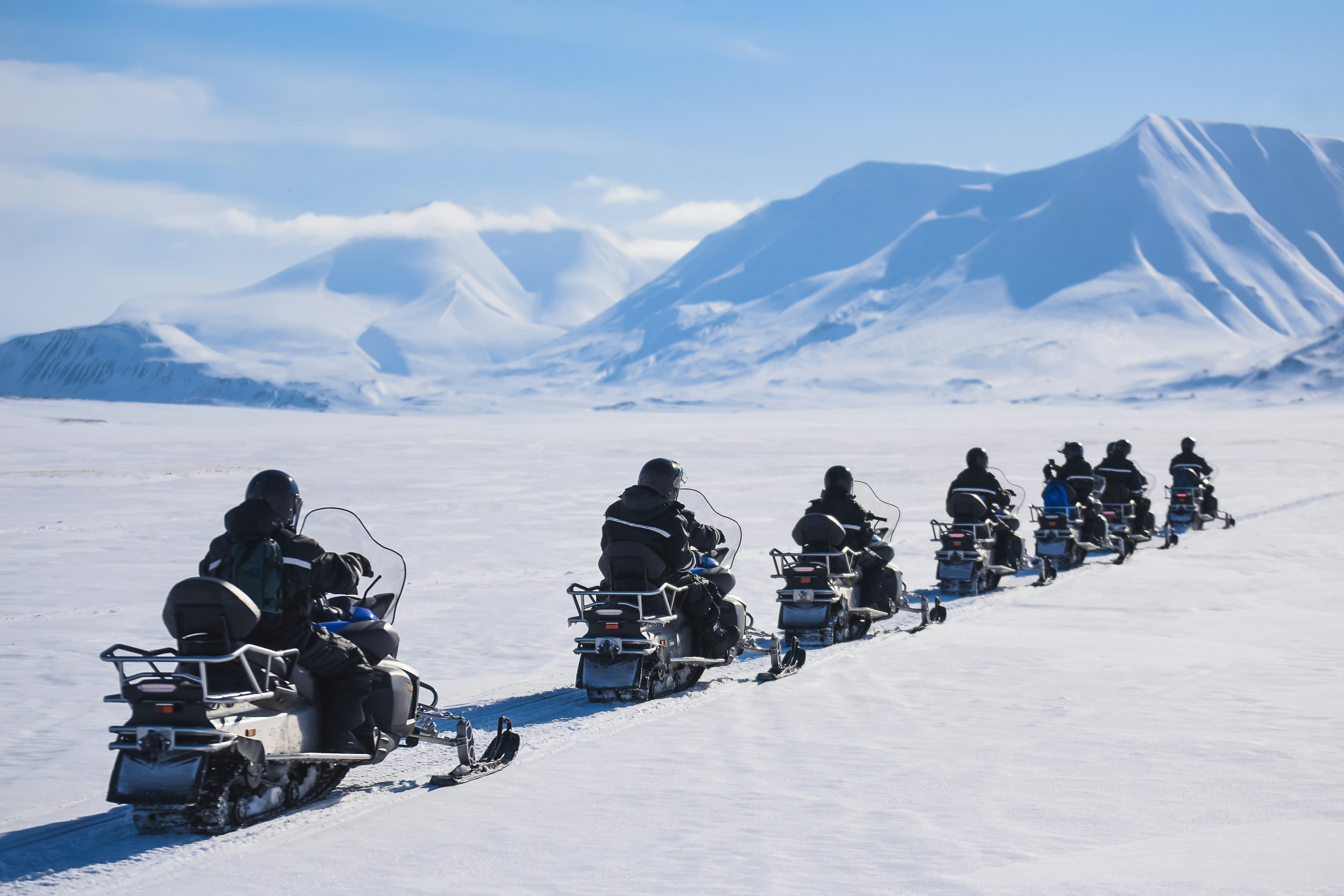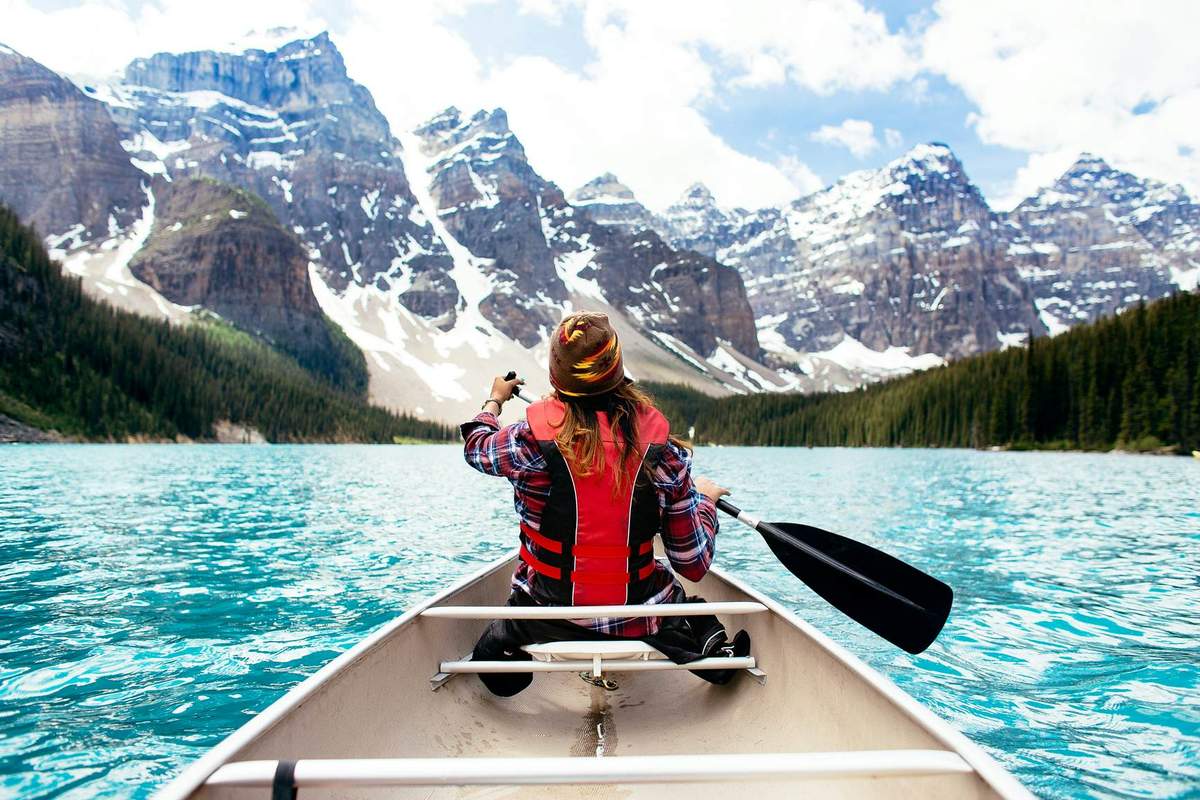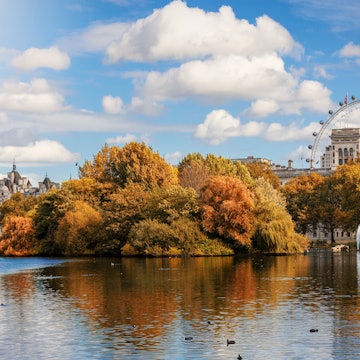

A Canadian polar bear near Churchill, Manitoba. chbaum/Shutterstock
As soon as the first flakes fall and the northern lights begin to flicker in dark winter skies, the call of the Alps and the Arctic is irresistible. Kit yourself out in warm gear and brace yourself for the thrill – whether it’s to be a shockingly cold float in a frozen river with the aurora blazing overhead in Sweden, a downhill dash on a retro-cool velogemel (part bike, part sled) in Switzerland, a snowmobile expedition into Svalbard’s great white open, or encounters with Sámi reindeer herders in Finnish Lapland.
Read on for our top eight winter trip ideas, each with a one-of-a-kind adventure at its heart.
1. Go on a polar bear safari in Churchill, Canada
As the first snow falls on the great rocky sweep of Hudson Bay in Manitoba, Canada, polar bear-watching season hits its peak. From mid-October to mid-November, polar bears gather on these frigid shores to wait for the big freeze, often under the glimmer of the northern lights. All winter long, they will use the Arctic sea ice as a platform for hunting seals. Around 1000 bears hang out here, giving Churchill the nickname "Polar Bear Capital of the World."
Seeing a polar bear emerge from the deafening silence is a spine-tingling moment you’ll be raving about forevermore. Fully grown males are big, reaching up to 3m (10ft) in height when standing on their hind legs and weighing a whopping 680kg (0.75 tons) – the size of a small car. Polar bear tour operators are abundant in Churchill, many offering tundra tours in heated buggies with viewing platforms). But for a real up-close-and-personal experience, go on foot. Churchill Wild dives deep with week-long polar bear photo safaris, based out of Nanuk Polar Bear Lodge. Hiking along the coast at sunrise, sunset and during the blue hour, gives polar bear sightings added magic.
Planning tip: Bring binoculars and keep your eyes peeled as it’s not just about the bears – you might well spot wolves, moose, Arctic foxes and hares, too.

2. See the northern lights in Iceland
As autumn ushers in longer, darker nights, the world’s greatest light show kicks off in the snow-blanketed wilds of the Arctic. You’ll draw breath when suddenly the skies shift and the mind-bending aurora borealis flashes green, pink and purple overhead like a wizard going crazy with a wand up in the heavens. It’s a heart-stopping moment as you lunge for your camera and witness a spectacle that’s truly out of this world.
While there are many places up north where you can get a ringside seat, Iceland is a chart-topper: at around 65° north, it’s right in the sweet spot of the aurora oval – the ring wrapping around the earth’s geomagnetic north pole. When solar activity is high and skies are clear, sightings are pretty much guaranteed. And the season runs long, with the lights dancing from September through April.
While you can head straight out of Reykjavík to glimpse this gorgeous display, the more remote you go, the better the odds. Stray deep into the wilds of this explosively beautiful land of craggy volcanoes and glaciers. The northern city of Akureyri makes a highly atmospheric base, especially if you observe the aurora from the steam-wisped, fjord-side pools of the Forest Lagoon.
Detour: For a more sensational backdrop still, head southeast to Jökulsárlón Glacier Lagoon, fringing Vatnajökull National Park, where the shimmering lights reflect in the ice. Go it alone or hook onto a guided tour.

3. Winter kayak in Norway
In a ruggedly mountainous, fjord-riven, waterfall-splashed, glacier-capped country where the natural beauty is off the charts, Arctic Norway makes for an epic winter trip. Norwegians embrace friluftsliv (outdoor living) wholeheartedly, no matter the weather, and are obsessed with the wild side. There are a million and one ways to experience this wilderness, none finer than slipping into a thermal suit and seizing a paddle to go on a multiday winter kayaking trip off the island of Rebbenesøya, a two-hour, fjord-hugging drive north of Tromsø (transfers can be arranged).
Kayaking in winter? You bet. At off-grid, eco-conscious Elements Arctic Camp, the pros take you paddling across crystal-clear waters and past pearly white peaks, as temperatures drop well below 0°C (32°F). The soft pastel light is enchanting and the rhythm of being out on the water is meditative, broken only by the occasional glimpse of a white-tailed eagle, otter or seal. As the northern lights come out to play, you can snuggle down by the wood-fired oven in a yurt.
Planning tip: To ramp up the adventure, combine kayaking with backcountry snowshoeing and cross-country skiing. Your hosts can provide all the equipment.

4. Learn about Sámi culture in Finland
Picture Finnish Lapland and Santa inevitably pops to mind – his official HQ being in Rovaniemi, where you’ll find reindeer, sparkly grottoes, present-packing elves and all. But there’s far more to these surreally beautiful Arctic realms than old St Nick. Like a Christmas card scene in winter, Lapland also enchants with its ringing silence and endless white expanse of frozen fells and snow-daubed taiga forests. The fabulous aurora borealis displays are extra special treats. The Finns call these lights revontulet, or "fox fires." As myth has it, they were created by an Arctic fox who sent sparks flying into the sky while running through the snow.
Lapland is the homeland of the Sámi, Indigenous reindeer-herding people from Finland’s far north. Their cultural pulse beats strongest in their lakefront capital, Inari, where you can tour Sámi Parliament, visit the state-of-the-art Siida museum for a deep dive into the Sámi’s nature-loving, season-driven way of life, or snowmobile out to Petri Mattus’ reindeer farm to feed the reindeer in the white wilderness.
Planning tip: Time your visit in late March to catch the grand finale of reindeer-racing season at the King’s Cup.

5. Snowmobile into the wilds in Svalbard
At 78° north, the island of Spitsbergen in the archipelago of Svalbard is the High Arctic proper and the last civilized stop before the north pole. A remote, fiercely beautiful wilderness of rock and ice, hulking mountains and frozen tundra, Spitsbergen has a sizable population of polar bears (locals carry guns just in case). Winters are harsh, with temperatures regularly plummeting to -20°C (-4°F) and blizzards blowing. During the dark days of the polar night (mid-November to mid-January), the sun never rises above the horizon, and the pink-purple-blue pastel light is dreamlike.
While you can get an inkling of the vast white world that’s out there from the main settlement of Longyearbyen, nothing beats hooking onto a multiday snowmobiling expedition. Once you’ve got the hang of it, you’ll soon be swooping and gliding over glaciers and frozen fjords, past jewel-colored lakes and former trapping huts, before finishing the day at a cozy, back-of-beyond cabin where the northern lights glitter. Polar bears often keep a low profile, but you might well spot Svalbard reindeer, Arctic foxes and walruses. Basecamp Explorer is a reliable pick.

6. Hang out with huskies in Greenland
The frantic howling and yelping of excited, run-hungry huskies and the thunder of paws in the frosty winter air is hairs-on-end stuff. While you can try your hand at mushing across much of the Arctic, dogsledding runs deep in Greenland, where some form of it has been practiced for the past 4000 years. Around 80% of Greenland is pure ice, so historically, dogsledding was a means of survival for the Inuit people – the only way to journey across frozen fjords to fish and hunt seals – in one of the world’s harshest climates.
As you push off, negotiating the curves and contours and gathering momentum to swoop and glide through the snowy backcountry and around frozen lakes, the feeling is one of utter freedom, almost like flying. Go dogsledding at night and you’ll often be treated to dazzling displays of northern lights.
At 69° north, Ilulissat in iceberg-packed Disko Bay is a tremendously scenic base for giving it a whirl. Pick a reliable operator, like World of Greenland, that offers everything from one-and-a-half-hour taster sessions to two-day extreme tours into the mountainous wilds, overnighting in a cabin near the glacier.
Planning tip: Peak season for dogsledding is February through April, when the snow conditions are perfect.

7. Dip into an ice bath in Sweden
If the temperatures make your teeth chatter with full-on thermals, plunging into the shockingly cold Arctic Bath in Harads in Sweden will make you gasp out loud. Adrift on the Lule River, which freezes over in winter, this architecturally striking spa hotel has been designed to look like a beaver’s logjam to evoke the river’s timber-transporting past. Its centerpiece is a circular, open-air, cold-water river pool, where a brave dip is said to boost mood, improve circulation and enhance immunity. Tip: warm up with a dry sauna and pine-oil massage after. Stay the night in one of the floating cabins and you might well see the northern lights glitter from your private deck.
More adventure, you say? Head slightly east to Filipsborg, the Arctic Mansion in Kalix, where you can round out days spent reindeer sledding, snowshoeing and snowmobiling with a magical ice float. Wearing a neoprene survival suit, you can float in icy waters and – if you’re lucky – gaze up at the northern lights flashing overhead.
Detour: For more snow fun, swing further north still to the Narnia-like Icehotel, built each year afresh from massive ice blocks hauled from the Torne River.

8. Ride a velogemel in Swiss Jungfrau
Skis? Snowboards? Frankly, they are not a patch on the vintage-cool velogemel, a crazy-looking wooden bike-sledge-ski hybrid used to zip down the mountains in Switzerland’s outrageously gorgeous, glacier-capped Jungfrau Region in the heart of the Bernese Oberland Alps. There are no breaks, pedals or gears, and wobbles are to be expected. But don’t fret: with a bit of pluck and practice, you’ll soon be whizzing down the icy slopes, with the mythical peaks of Eiger, Mönch and Jungfrau looming large on the horizon. It’s super-fast, so dig your heels in hard if you want to slow things down a little.
Grindelwald is the birthplace of the velogemel, originally designed in 1911 by Christian Bühlmann, the son of a sawmill owner who contracted polio, which left him with mobility issues. He saw the light in this unique and ingenious contraption, which was soon used as a means of getting around the snowy streets by everyone from postal workers to doctors. Now the velogemel is having a revival as a green alternative to conventional winter sports.
















